Table 1.
Promising plant origin natural products for bladder cancer therapy.
| Plant Origin Compounds | Source | Structure | Mechanisms | Related Factors | Ref. |
|---|---|---|---|---|---|
| (−)-Gossypol | Cotton plants |

|
Inducing apoptosis through caspase-mediated signaling pathways | caspase-3, caspase-9, Bcl-xl, Mcl-1, Bim, and Puma | [33,34,35] |
| (−)-epigallocatechin-3-gallate (EGCG) | Green tea |
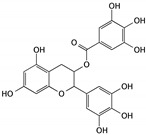
|
Inducing apoptosis associated with the PI3K/Akt signaling pathway | Bcl-2, Bcl-xL, Bcl-2, Bcl-xL, caspase-3, and PARP | [36,37,38] |
| Ellagic acid | Fruits and some mushrooms |
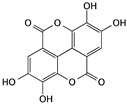
|
Inducing apoptosis through the mitochondrial pathway | caspase-3, caspase-9, Bax, and cytochrome c | [39,40,41] |
| Thymol | Thymus serpyllum L. |

|
Triggering apoptosis via the intrinsic pathway | Bcl-2, Bcl-xl, Mcl-1, cytochrome c, and Smac/DIABLO | [42,43] |
| Apigenin | Fruits and vegetables, like parsley, celery, celeriac, and chamomile tea |

|
Inducing apoptosis through the PI3K/Akt signaling pathway | Bax, Bad, Bak, Bcl-2, Bcl-XL, Mcl-1, caspase-3, 7, 9, and PARP | [45,46,47] |
| Kaempferol | Hamamelis mollis |

|
Inducing apoptosis associated with the PI3K/Akt signaling pathway | AKT, Bid, Mcl-1, Bcl-xL, p53, p21, p38, Bax, and Bid | [48,49,50,51] |
| Baicalein | Scutellaria baicalensis |

|
Inducing apoptosis and cell cycle arrest; inhibiting cell migration | p16, p21, p38, CDC2 Bcl-2, Bax, caspase-3, and caspase-9 | [52,84] |
| Curcumin | Curcuma spp. plants |

|
Inducing apoptosis and cell cycle arrest | caspase-3, caspase-7, PARP, Bcl-2, p21, p27, cyclin D1 and cyclin E1 | [53,54,55,56] |
| Kazinol A | Broussonetia papyrifera |
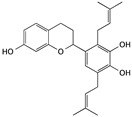
|
Inducing apoptosis associated with the AKT signaling pathway | p-AKT, p-Bid, Mcl-1, and Bcl-xL | [59] |
| Boldine | Peumus boldus |
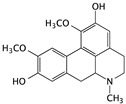
|
Inducing apoptosis mechanism associated with the ERK and AKT signaling pathway | p-AKT, p-ERK, and p-GSK-3β | [61,62] |
| Lycorine | Amaryllidaceae genera |
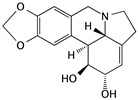
|
Inducing apoptosis | p-ATK, caspase-3, and Bax | [63] |
| Tetrandrine | Stephania tetrandra |
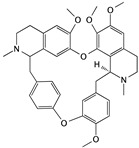
|
Inducing apoptosis associated with the mitochondrial pathway | caspase-3, caspase-9, and cytochrome c | [64] |
| 6’-hydroxy justicidin A | Justicia procumbens |
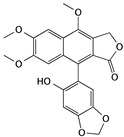
|
Inducing apoptosis associated with the mitochondrial pathways | caspase-3 and caspase-9 | [65] |
| Fucoidan | Algae and seaweeds |

|
Inducing apoptosis through the PI3K/Akt signaling pathway; inducing cell cycle arrest in the G1 phase; antiangiogenic and inhibiting cell migration and invasion | Fas, MMP, Bax, Bcl-2, cytochrome c, p21, CDK4, CDK6, p-RB, HIF-1α, and VEGF | [66,67,68,73,83] |
| Berberine | Berberis |
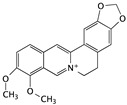
|
G0/G1 cell cycle arrest and inducing apoptosis | caspase-3 and caspase-9 | [74] |
| Silibinin | Thistle |

|
Inhibiting cell migration and invasion | mesenchymal markers, N-cadherin, vimentin, β-catenin, ZEB1, E-cadherin, COX-2, and MMP-2 | [80,81] |
| Magnolol | Magnolia officinalis |

|
Inhibiting tumor angiogenesis | HIF-1a and VEGF | [82] |
